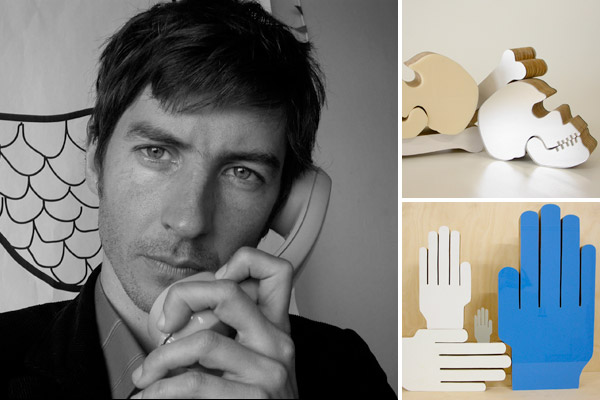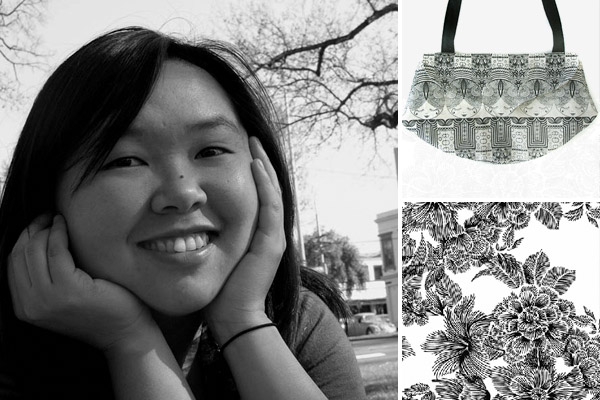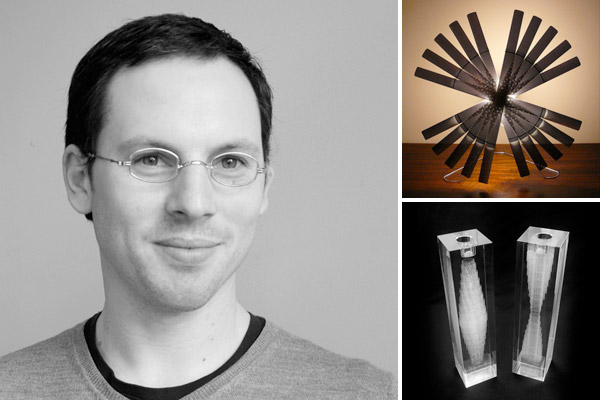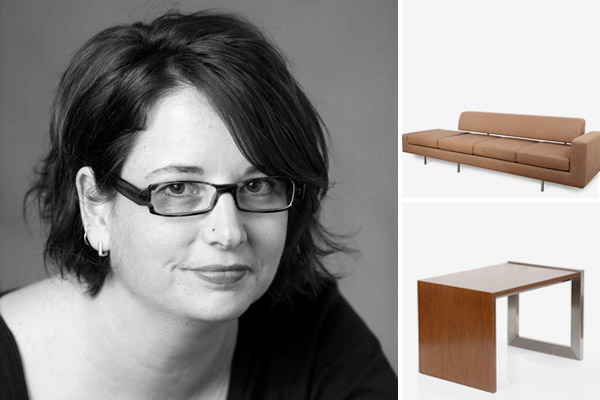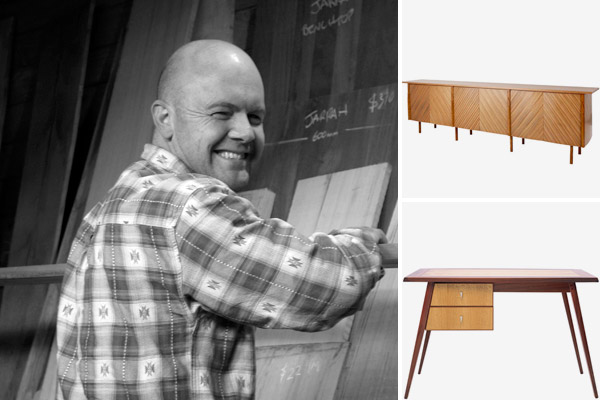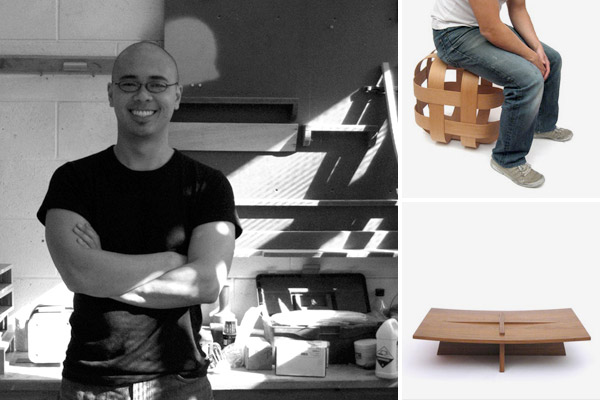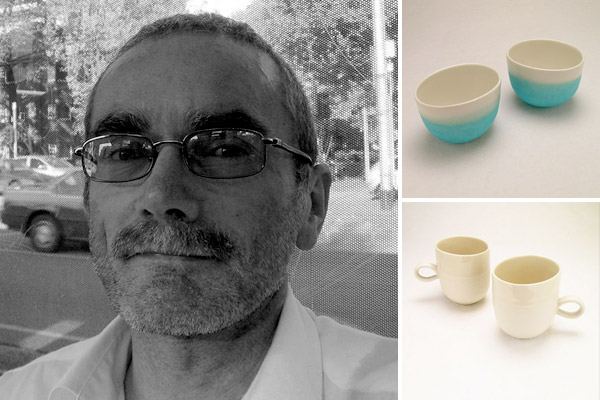July 2008
Tor White
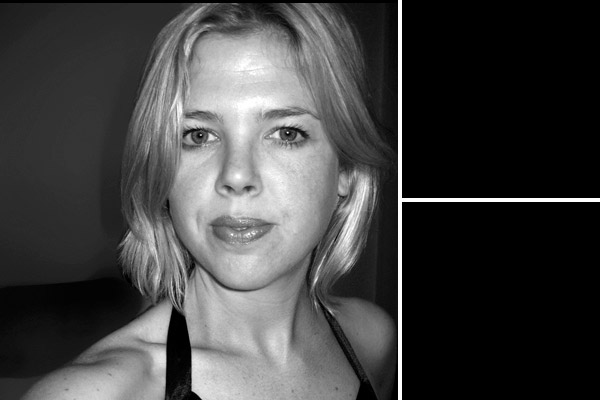
white with one sugar | Email | Website
Where and what did you study and what year did you graduate?
Diploma in Computer Graphic Design, 2001, National College of Design and Technology, New Zealand.
Bachelor of Arts, 2000, Canterbury University.
Where did you head after graduating?
Immediately after graduating, I flew to Sydney with my folio under my arm. I landed on my feet as in house designer at Ruby Star Traders and haven’t looked back.
When did you launch your own business?
In November 2004.
What motivated you to start your own business?
It was the desire to be self-defined and independent.
How would you describe your business to someone who didn’t know you?
white with one sugar is graphic design consultancy. I conceptualise, create and deliver all forms of print design and surface pattern from branding to textiles.
How would you describe the products you design to someone who hadn’t seen them?
Considered, crafted and refined graphic design.
What are the most challenging parts of being a designer running a small business?
I am my own creative director, accountant, IT department, publicist and harshest critic… Christmas parties tend to be a little quiet.
What inspires your design projects?
Things inspiring me now are Stefan Sagmeister’s maxims, artists Cai Guo-Qiang and Olafur Eliasson, Cydwoq shoes and an architect from the firm Herzog & de Meuron who swims to work in Basel, Switzerland.
What are the next steps for you?
white with one sugar will shift from being client based to product driven.
Comments Off on Tor White
Tim Fleming
Where and what did you study and what year did you graduate?
Bachelor of Arts Honours (Fine Art), 2000, RMIT.
Bachelor of Fine Arts, 1995, Monash University.
Bachelor of Arts (Photography), 1992, RMIT.
Where did you head after graduating?
I travelled for a few years, worked in attendant care for people with physical and intellectual disabilities and practised as an artist full time for a number of years with six solo exhibitions.
When did you launch your own business?
In 2004.
What motivated you to start your own business?
I was interested in working for myself in a creative and ethical way that would allow me the income to do the things I want to do. For example, ride horses, create a lovely garden and make really good work that I can be proud of.
How would you describe your business to someone who didn’t know you?
I would say that what I do is a creative practice with branches. I operate a small business designing and making handmade objects.
How would you describe the products you design to someone who hadn’t seen them?
I always struggle with this. Often people’s eyes start to glaze so I try to avoid it .I also avoid asking people what they do directly. I am more interested in why people do things.
What inspires your design projects?
Countless people in all fields. What drives me is the possibility of developing over a long period of time a very sophisticated body of work that communicates on a number of levels.
What are the next steps for you?
I do feel like I am at the tip of the iceberg and I have a lot of work to do. I intend to keep working hard. I have just secured representation in Europe which is something I have been working towards for a long time.
Tim Fleming received a scholarship from Design Victoria to participate in Springboard Stage One.
Comments Off on Tim Fleming
Roland Smith
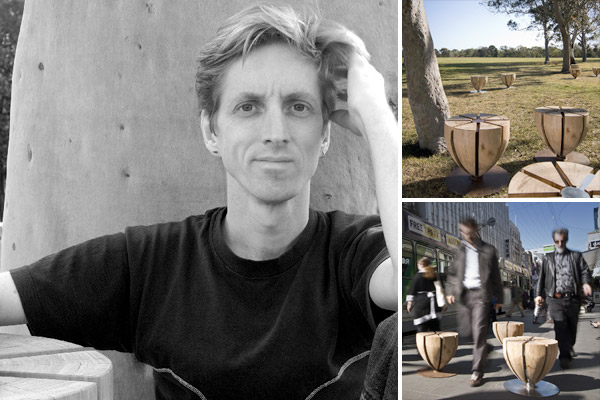
Watermoon Design | Email
Where and what did you study and what year did you graduate?
Diploma of Arts (Furniture Design), 2007, RMIT.
Bachelor of Visual Arts, 1998, Sydney College of the Arts, University of Sydney.
Diploma in Foundation Studies (Fine Art), 1995, Camberwell College of Arts, The London Institute.
Where did you head after graduating?
In 2008 I started Watermoon Design and have been focusing on bringing my Gumnut Spinning Chairs to market.
What motivated you to start your own business?
I was motivated by a desire to create beautiful objects and spaces. I wanted to install and build products that celebrated the planet without leaving a damaging environmental footprint. I was also inspired by the opportunity to be the author of my own life and influence design and designers in Australia, making sure we grab the opportunity we have be world leaders in sustainable design.
How would you describe your business to someone who didn’t know you?
Watermoon Design is a furniture, object, interior and exterior space design and custom furniture making business with a commitment to having a creative and visual impact with minimal environmental footprint.
How would you describe the products you design to someone who hadn’t seen them?
Stylish elegant and comfortable furniture and spaces inspired and informed by biological forms, materials and the object’s purpose. We focus on sustainable, recyclable and recycled materials.
What are the most challenging parts of being a designer running a small business?
I think the most challenging part is balancing time and business priorities with creative research and inspiration.
What inspires your design projects?
Our planet and its geological forms and the millions of flora and fauna species we share it with, especially those in Australia. Also a commitment to minimising product’s environmental impacts.
What are the next steps for you?
I want to design and make a number of products for manufacture, work with clients to create objects that they love and inspire them while helping them minimise their impact on the earth.
Comments Off on Roland Smith
Robert Young
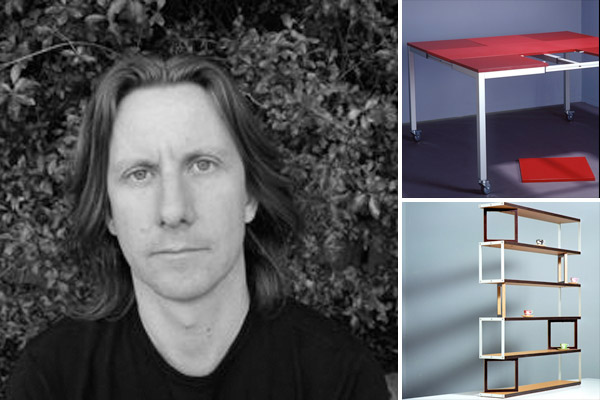
Profile Furniture | Email | Website
Where and what did you study and what year did you graduate?
Diploma of Arts (Wood Design), 1995, Boxhill TAFE.
Where did you head after graduating?
After graduating, I was a founding member of the Victorian Design Group (VDG), a furniture design co-operative started by Boxhill graduates. I then practiced from the VDG between 1995 and 2000.
When did you launch your own business?
I launched Profile Furniture in 1998 as a group partnership. The business then became an official partnership in 2000 and a limited company in 2003.
What motivated you to start your own business?
When I was studying design I came to the realisation that no one was going to beat a path to my door or offer me a clear career path once I graduated. So it was ultimately up to me to create a design position for myself by starting my own business.
How would you describe your business to someone who didn’t know you?
Profile Furniture is a design, manufacturing, retailing, offshore production and importation business.
What are the most challenging parts of being a designer running a small business?
It’s been setting up the infrastructure, learn how to manage employees and the finances in order to support the creative side of the business.
What inspires your design projects?
Most of my design projects have their roots in residential design briefs established with my clients. The most promising of these designs would then be developed into limited run products.
What are the next steps for you?
I hope to leverage the established retail, manufacturing and off shore production base to support the establishment of a design team and to reinvigorate the design/retail side of the business here and overseas. Also to successfully negotiate the change from a small business, to a medium sized business, growing from 10 to 15 employees and adding both an admin and design department.
Comments Off on Robert Young
Quyen Do
Where and what did you study and what year did you graduate?
Bachelor of Environmental Design/Architecture, 1999, University of Western Australia.
Diploma Fashion & Textile Design, 2004, Western Australia School of Art.
Where did you head after graduating?
I worked in Hiroshima in Japan, freelanced as a textile designer, lectured in design at Central TAFE and worked for a Western Australian company in digital surface pattern design.
When did you launch your own business?
In 2005.
What motivated you to start your own business?
I had a desire to put my pattern designs on my own products and creative energy into something I could do myself from start to finish. Also I love seeing people cruising around with one of my bags!
How would you describe your business to someone who didn’t know you?
It’s a one woman show with the occasional buddy who has the day off work and wants to help out. The business is small and tactile, everything is hand created and made to order.
How would you describe the products you design to someone who hadn’t seen them?
Colourful, fun, organic, handy and surprisingly sturdy.
What inspires your design projects?
Looking hard at everyday life, making something new from what we already know, travel, talking to children, photography, being outdoors, drawing is key for me – you never know what a simple sketch can become.
What are the next steps for you?
I would like to produce on a larger scale and be stocked internationally. My product is known for its handmade quality so I am wary of mass manufacture. I would like to keep it simple… If I could get a few clones of myself that would be ideal!
Quyen Do received a scholarship from the State Government of Western Australia through the Department of Culture and the Arts to participate in Springboard Stage One.
Comments Off on Quyen Do
Paul Justin
Where and what did you study and what year did you graduate?
Bachelor of Industrial Design, 1997, RMIT.
Where did you head after graduating?
I established a business partnership to bring to market a product. This led to me winning Young Victorian Designer of the Year 1999. Looking for more experience, I then established the in house design studio for Buzz Products, designing an endless variety of objects and packaging for airline, beauty, fast food and FMCG clients, to name but a few.
When did you launch your own business?
I established my own studio in March 2007.
What motivated you to start your own business?
My sketchbooks told me to do it. The ultimatum was to breathe life into the ideas contained within their pages or suffer an eternal barrage of papercuts.
How would you describe your business to someone who didn’t know you?
Paul Justin Pty Ltd is founded on the strength of ideas and the idiosyncrasies of the human experience. The scope of projects is broad spanning furniture, toys, fine objects and domestic goods.
How would you describe the products you design to someone who hadn’t seen them?
Whilst my works are varied in use, there are threads which hold them together. I am interested in finding simple solutions with ingenuity and adaptation and modularity of products. I also want to instill a relationship between product and person and aim to make significant but incremental steps towards sustainable practice, in line with the principles of Cradle to Cradle.
What are the most challenging parts of being a designer running a small business?
Taking an objective curatorial stance on which ideas are worth pursuing. Also taking time from the meditation of design to nurture the business side of the studio.
What inspires your design projects?
Pure geometry, observations of my children at play and natural rhythms. When I look at an object I try to see both the vase and the faces that make it.
What are the next steps for you?
The coming years should see a number of my ideas produced. I am currently in promising discussions with some companies on the fate of a few.
Comments Off on Paul Justin
Nina Oikawa
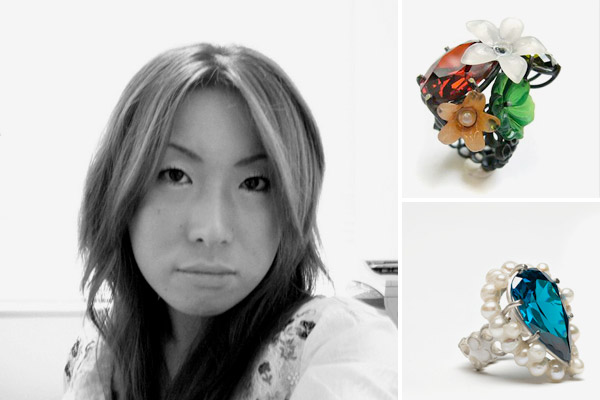
Nina Oikawa | Email
Where and what did you study and what year did you graduate?
I’m currently enrolled in a Doctorate of Fine Art (Gold & Silversmithing) at RMIT, due to finish in 2009. I’m also a second year student at the Gemological Institute of Australia.
Master of Fine Arts (Gold and Silversmithing), 2005, RMIT University.
Bachelor of Fine Arts Honours (Metal and Jewellery), 2004, Monash University.
Bachelor of Applied Art (Metal and Jewellery), 2003, Monash University.
Where did you head after graduating?
In 2006, I received the Gallery Marzee graduate prize in the Netherlands. Part of the the prize was then to participate in the Atelier Ravary workshop in Belgium. I was also selected to be in the Talente international exhibition in Munich 2007 and in art prizes and trade fairs in New York and The Netherlands. In the last three years I have also had three solo shows across Melbourne and Sydney.
When did you launch your own business?
I haven’t launched it officially but I have been producing work for several years.
How would you describe your business to someone who didn’t know you?
My work investigates jewellery making possibilities and the relationships of resin casting informed by a curiosity towards materials and spatial relationships.
How would you describe the products you design to someone who hadn’t seen them?
Contemporary art jewellery created from various materials, precious metals and gems and non-precious materials.
What inspires your design projects?
My most recent works were developed from a workshop focusing on nature held in April 2007 in Belgium. They are also a result of experiments with precious and non-precious materials and incorporate found objects.
What are the next steps for you?
I’d like to produce and sell more high end jewellery in my contemporary designs including materials such as gold, platinum and top quality precious gems.I would also like to work more on engagement and wedding rings and set up my studio.
Nina Oikawa received a scholarship from Design Victoria to participate in Springboard Stage One.
Comments Off on Nina Oikawa
Nathan Day
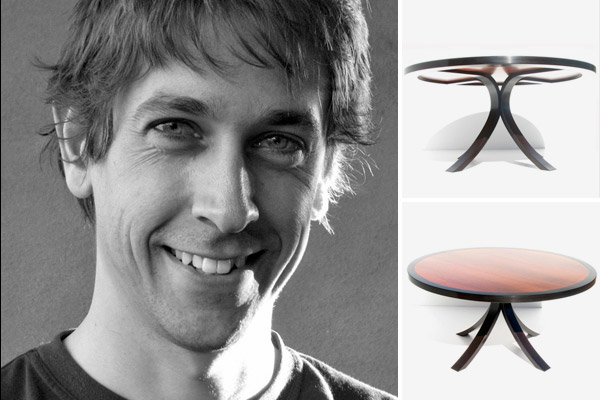
Nathan Day Furniture and Design | Email | Website
Where and what did you study and what year did you graduate?
Certificate III Furniture Making, 2001, South West Regional College of TAFE.
Where did you head after graduating?
In 2005, I was the recipient of an Australian Overseas Foundation Scholarship. This scholarship allowed me to complete a year traineeship at the Edward Barnsley workshop from 2005 to 2006.
When did you launch your own business?
In September 2007.
What motivated you to start your own business?
A drive to be independent and a chance to address what I saw to be lacking in most of today’s furniture. I felt that the individually made pieces lacked a contemporary aesthetic and the commercially designed and produced were getting more impersonal.
How would you describe your business to someone who didn’t know you?
My business is a small furniture design and manufacturing business that produces high end, limited edition and bespoke pieces.
How would you describe the products you design to someone who hadn’t seen them?
I produce individually made, luxury, contemporary furniture. Each product is elegant, delicate, graceful and design driven with a craft-based approach to the making.
What inspires your design projects?
The natural environment and my local area give me a lot of inspiration. My work is also inspired by contemporary design and modern architecture. The making is very much inspired by English craft furniture.
What are the next steps for you?
I want to spread the word, get people excited about my work and drive things forward. In the future, I want to employ and educate other designers and build an innovative inspiring business.
Nathan Day received a scholarship from the State Government of Western Australia through the Department of Culture and the Arts to participate in Springboard Stage One.
Comments Off on Nathan Day
Matthew Herbert
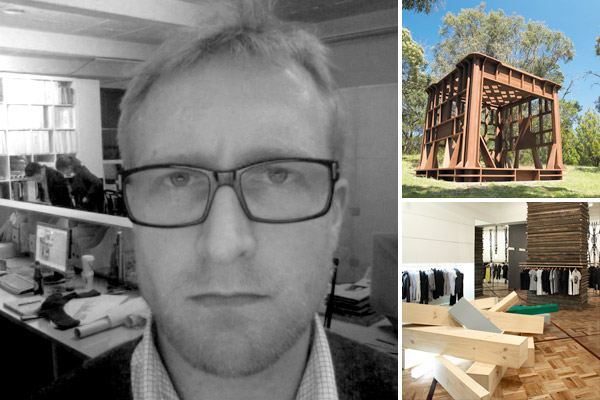
Herbert + Mason | Email | Website
Where and what did you study and what year did you graduate?
Bachelor of Architecture Honours (First class), 2003, RMIT.
Where did you head after graduating?
I moved to New Zealand and rebuilt a house high up on a hill for a client who lived in Japan. I then came back to Melbourne.
When did you launch your own business?
In 2006.
What motivated you to start your own business?
There was always a plan to establish a practice. At some point the amount of work we were doing after hours validated doing it during hours. Now we work all hours.
How would you describe your business to someone who didn’t know you?
We are architects. We design objects, build buildings, create spatial solutions and solve three-dimensional problems.
How would you describe the products you design to someone who hadn’t seen them?
They are ideas. We build them. We design objects for people to use, spaces for people to inhabit and installations for people to experience.
What are the most challenging parts of being a designer running a small business?
Being a designer who has to become a business person.
What inspires your design projects?
Collaboration, constraints, solutions, process, realisation.
What are the next steps for you?
We will establish our studio further, work with creative and enthusiastic people, establish good communications with clients and colleagues and build a reputation for our ideas and work.
Comments Off on Matthew Herbert
Matthew Harding
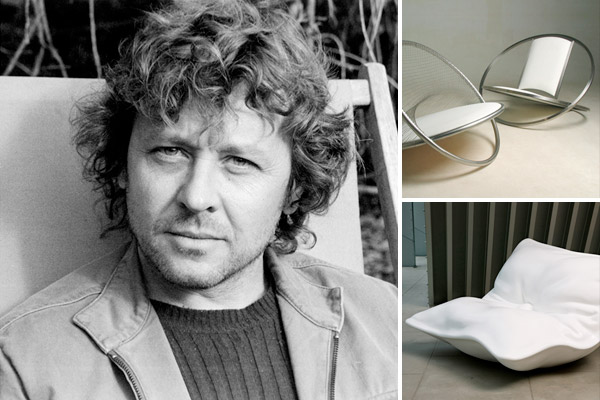
Matthew Harding Art + Design | Email | Website
Where and what did you study and what year did you graduate?
Bachelor of Visual Arts Honours (First class), 1995, Canberra School of Arts, Australian National University.
Where did you head after graduating?
I have been working full time as a sculptor and designer.
When did you launch your own business?
I launched my business in 1995.
What motivated you to start your own business?
The desire and compulsion to create and the will to succeed.
How would you describe your business to someone who didn’t know you?
My business encompasses design and sculpture on a small and large scale in a broad range of media, spanning craft and industry.
How would you describe the products you design to someone who hadn’t seen them?
They are bending or breaking preconceived notions of function and form.
What are the most challenging parts of being a designer running a small business?
The challenge of finding the most innovative solution to the problem, finding the energy and adrenaline to keep going and the challenge of remaining positive when setbacks, knock backs and lack of finances takes you to the brink.
What inspires your design projects?
Lateral thinking, the ability to consider and take onboard all the options, drown in the possibilities and surface clinging to the best solution.
What are the next steps for you?
I want to hone and focus the strong aspects of my business, streamline the administrative and let go of the weaker elements. The plan is to venture out on open waters.
Comments Off on Matthew Harding
Martin Davis
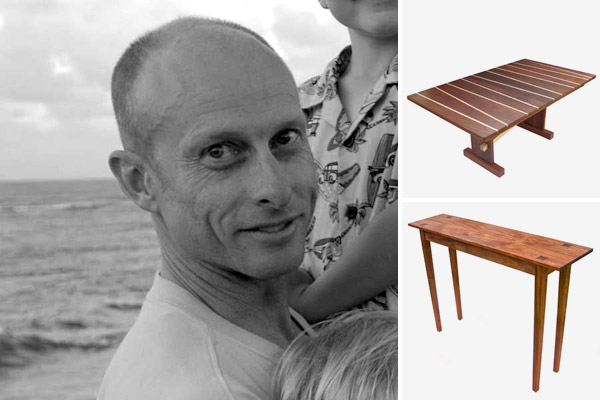
Martin Davis Furniture Design | Email | Website
Where and what did you study and what year did you graduate?
Graduate Diploma Multimedia, 2002, Swinburne University.
Bachelor Applied Science (Landscape Architecture), 1987, RMIT.
Where did you head after graduating?
After graduating in 1987, I established my own landscape architectural practice which I remained a director of for 13 years. After graduating in multimedia in 2002, I proceeded to educate myself in all areas of furniture design and construction.
When did you launch your own business?
Landarche Pty Ltd was launched in 1988 and Martin Davis Furniture Design in 2003.
What motivated you to start your own business?
The motivation to start my current business came from the desire to pursue my interest in furniture design and to remain self-employed.
How would you describe your business to someone who didn’t know you?
The business currently consists of two informal divisions. The first division produces handcrafted furniture designed and made to commission. The second prototypes furniture design and production intended for manufacture.
How would you describe the products you design to someone who hadn’t seen them?
My furniture is unique and contemporary and intended to last for generations. My commission furniture and prototypes are made primarily from reclaimed Australian hardwoods and plantation sheet material.
What are the most challenging parts of being a designer running a small business?
It’s hard to compete with established celebrity designers for manufacturers and retailers’ interests and finding time to do everything that needs to be done.
What inspires your design projects?
My design projects are influenced largely by my tertiary qualifications, extensive overseas travels and an interest in the visual arts.
What are the next steps for you?
I plan to further develop the commissioned furniture side of the business to a point where it maintains a more constant cash flow. I will continue to design and make new prototypes and research and develop manufacturing and marketing strategies.
Comments Off on Martin Davis
Malcolm Thomas
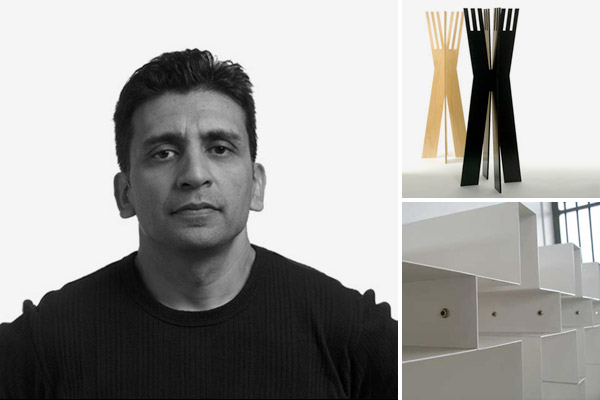
malthomasdesign | Email
Where and what did you study and what year did you graduate?
Master of Arts (Furniture and Related Technology), 1985, Buckingham College of Higher Education, England.
Bachelor of Arts (Three-dimensional design), 1982, Middlesex Polytechnic, London.
Where did you head after graduating?
After graduating I worked for a bespoke furniture designer and making company. I fell in love with making and asumed that knowing how to make would make be better designer. In my holidays and spare time I would prototype up my own designs to start building a profile and folio.
When did you launch your own business?
In 2002.
What motivated you to start your own business?
I wanted control over a creative role and to focus on a form and process that facinated me personally.
How would you describe your business to someone who didn’t know you?
My designs come from facination with form, shape and texture. There is a particular interest in having a theme. This may be bringing human form into the design or trying to build a structure using identical elements.
How would you describe the products you design to someone who hadn’t seen them?
I design furniture that varies in purpose and scale. I like designing items where the production process influences the aesthetic. The designs are simple and modern, no applied ornamentation using materials that are natural or are sustainable.
What are the most challenging parts of being a designer running a small business?
Money and time. Prototyping is costly. Designs need refining which means several versions that all need consideration. Marketing my work tends to be done on the run.
What inspires your design projects?
Natural forms, shapes in sculpture, art and architecture. Materials are a good starting point.
What are the next steps for you?
I would like to consolidate a range of products and items that I sell and draw attention to what I can do. I would like to raise my profile enough for design houses and manufacturers to take me on and commission me.
Comments Off on Malcolm Thomas
Lucy King
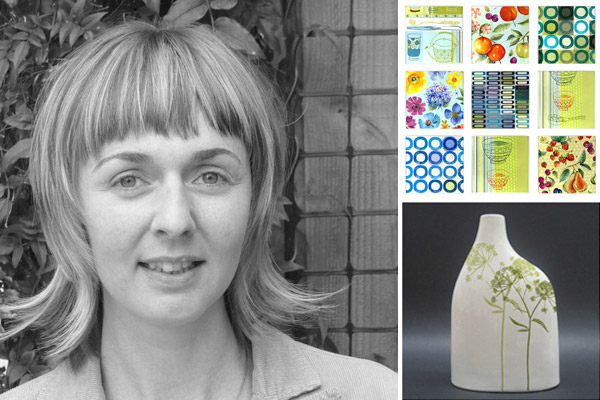
Lucy King Design | Email
Where and what did you study and what year did you graduate?
Master of Arts (Ceramic Design for Production), 2000, Staffordshire University, United Kingdom.
Bachelor of Arts Honours(Textile Design), 1997, University of Derby, United Kingdom.
Where did you head after graduating?
I was invited to work with Wedgewood in the UK as a designer for tableware.I have also worked on a freelance basis designing products for Marks & Spencer and the National Trust and collaborated with Dansk on a range of products.In 2001 I relocated to Australia and continued to operate a freelance design business.
When did you launch your own business?
I have been operating as a freelance designer since 2000, but it has only been recently I have started to actively explore the idea of developing my own product range.
What motivated you to start your own business?
Being accepted onto the Springboard program! As a designer in a freelance capacity and for inhouse studios, I have spent many years helping to expand a clients image and brand name, and create products that sell I decided it was time to put the same time, effort and commitment into exploring my own product range.
How would you describe your business to someone who didn’t know you?
I have a distinctive handpainted illustrative style and my main focus is to develop a range of individual tabletop products.
How would you describe the products you design to someone who hadn’t seen them?
My illustrations are characteristic of washy overscaled floral motifs with a fluid style and feature unusual placements. I am also exploring additional non-floral imagery, and have numerous ideas for themes and ranges the possibilities are endless!
What are the most challenging parts of being a designer running a small business?
Financial, there’s never enough money and what you want to do is highly expensive and trying to remain focused, positive and confident about following your idea.
What are the next steps for you?
I am in the initial stages of development but would like to exhibit the products at local and international trade shows, get a range of products into stores locally and research overseas stores.
Comments Off on Lucy King
Lee Darroch
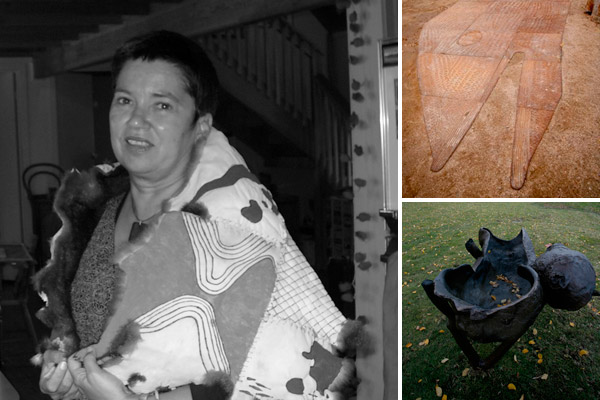
Gurranyin Arts
Riverbank Arts Pty Ltd. | Email
Where and what did you study and what year did you graduate?
Certificate in Koori Art & Design, 1998, East Gippsland TAFE.
Certificate in Small Business Management, 1990, Clarke Carthew & Associates Pty Ltd., Melbourne
Bachelor of Social Work, 1980, Preston Institute of Technology.
Where did you head after graduating?
For ten years I worked as the Manager and Koori Arts Worker for East Gippsland Aboriginal Arts.
When did you launch your own business?
My business Gurranyin Arts was launched in 1996 when I exhibited in the Access Gallery of the National Gallery of Victoria. Riverbark Art Pty Ltd was launched in 2007.
What motivated you to start your own business?
I have a passion to create, design and make beautiful Koori art that has a meaning and resonance and to continue our cultural traditions into the future with new, modern materials.
How would you describe your business to someone who didn’t know you?
Gurranyin Arts is a Koori design, arts and cultural business that produces meaningful, beautiful graphic arts, public art and fine art. Riverbark Arts Pty Ltd is a Koori owned and managed company. It runs large scale projects in arts and culture, undertakes project management and cultural consulting and will manufacture products upon request.
What are the most challenging parts of being a designer running a small business?
The two main challenges now for Gurranyin Arts’ development are managing family and work life and also financial management.
What inspires your design projects?
The land, connection to country, culture and traditions, a desire to educate others about our culture and a passion to make things.
What are the next steps for you?
The next steps are to gain a business mentor to assist with financial planning, to do market research into possible commercially viable designs for the future and to design, manufacture and find retailers for a product range.
Lee Darroch received a scholarship from the Australian Design Unit to participate in Springboard Stage One.
Comments Off on Lee Darroch
Katrina Tyler
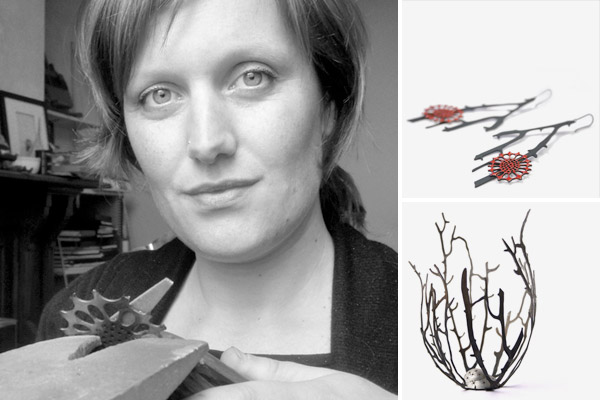
Katrina Tyler Jewellery Design | Email
Where and what did you study and what year did you graduate?
Bachelor of Fine Arts (Gold and Silversmithing), 2003, RMIT.
Where did you head after graduating?
I worked on my practice as part of Ludo jewellery collective. In early 2005 I went on a trip around Australia. My travels took me to Darwin where I stayed for three years. In 2007 I received a Territory Craft grant, which enabled me to work for three months in the metal design studio at JamFactory in Adelaide.
When did you launch your own business?
I launched my business officially in February 2008.
What motivated you to start your own business?
I had been wanting to do it for some time. I felt I had accumulated an adequate suite of ideas and skills to enable me to start and commit to running a business. The ability to control the direction of my business and flexibility to tackle new projects is most rewarding, as well as seeing the full potential of my ideas begin to flourish.
How would you describe your business to someone who didn’t know you?
I am a designer and maker who creates jewellery and small and large scale sculptural objects.
How would you describe the products you design to someone who hadn’t seen them?
My jewellery and sculptural objects utilise non-traditional materials and techniques such as enamelling onto mild steel. The pieces tend to be graphic in nature and are comprised of cut-out elements derived from natural patterns and forms.
What are the most challenging parts of being a designer running a small business?
Maintaining a sense of total organisation that allows for the clear headspace I tend to require for the finalisation and processing of my designs.
What inspires your design projects?
A desire to capture and reinterpret the beauty I find in objects, phenomena and layers I observe in and collect from my surroundings.
What are the next steps for you?
I will continue to show my work in solo and group exhibitions as well as further developing my range for sale through galleries and stores. I will seek further opportunities to design and create public sculpture or large scale projects.
Comments Off on Katrina Tyler
Katherine Brennan
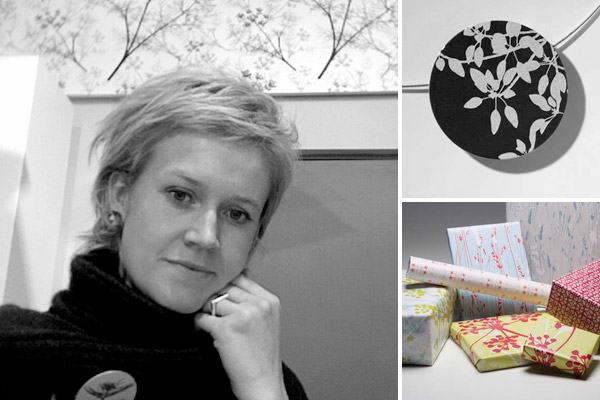
KIF & KATAST | Email | Website
Where and what did you study and what year did you graduate?
Bachelor of Arts (Graphic Design), 1998, Swinburne University of Technology.
Where did you head after graduating?
I travelled overseas from 1998 to 2002. Based in London, I worked in a branding capacity for Twigg Brown Architects. Between projects I travelled through China, South America, Eastern Europe, Scandinavia, North America, Turkey, Egypt and parts of Europe.
When did you launch your own business?
In 2003 I returned to Australia and opened a design practice the focus of which was redirected in late 2005 when I established a wholesale design business. In October 2007, I opened KIF & KATAST, a retail store featuring our range alongside works of established and emerging, local and international artists and designers.
What motivated you to start your own business?
I wanted to be able to invest more time in the design process and set my own briefs based around niches which I identified in the marketplace.
How would you describe your business to someone who didn’t know you?
Multifaceted!
How would you describe the products you design to someone who hadn’t seen them?
A diverse yet aesthetically cohesive range of products which are underpinned by my graphic design background and more importantly my love of photography, plants, gardens and architecture.
What are the most challenging parts of being a designer running a small business?
The most challenging part of running a small business is funding delegation.
What inspires your design projects?
Ideas, photography, endless industrial estates, the potential they possess, the thrill of embracing new processes and getting mud on your boots.
What are the next steps for you?
My current focus is to take a step back to critically access my business, work processes and designs before hiring someone amazing who can quietly sell ice to eskimos to maximise our sales potential.
From a design perspective, I intend to increase my range of architecturally focused products.
Comments Off on Katherine Brennan
Kath Inglis
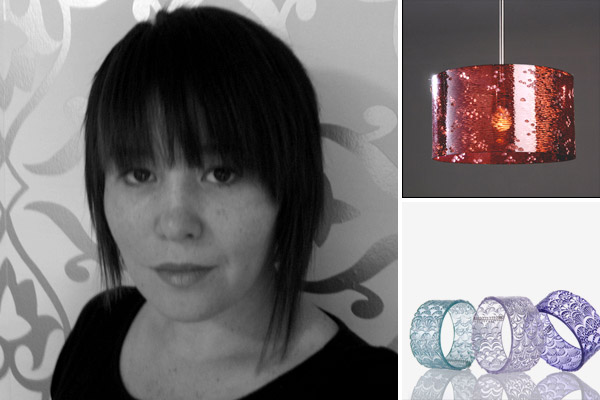
soda and rhyme | jewellery design studio | Email | Website
Where and what did you study and what year did you graduate?
Bachelor of Applied Arts (Jewellery and Metalsmithing), 2000, South Australian School of Art, University of South Australia.
Where did you head after graduating?
After graduating I was an access tenant at Gray Street Workshop and have been an Associate Designer with JamFactory Metal Design Studio and artist in residence in Territory Craft Darwin studio. I also undertook a CraftSouth mentorship with Catherine Truman.
When did you launch your own business?
I launched my own business in 2001.
What motivated you to start your own business?
I wanted to be a contemporary jeweller and starting my own business was the way to do it.
How would you describe the products you design to someone who hadn’t seen them?
Essentially my work is hand carved plastic jewellery and I enjoy the many hours required to create each piece.
What are the most challenging parts of being a designer running a small business?
Wearing all the different hats required to run and grow your business. And you really need to wear them all well. One bad hat can let you down!
What inspires your design projects?
The world around me.
What are the next steps for you?
I would like to expand into exporting my work. I would also like to have all stockists purchasing my work and not taking jewellery on consignment.
Comments Off on Kath Inglis
Julie Pieda
Where and what did you study and what year did you graduate?
Associate furniture designer, 1996-98, JamFactory Contemporary Craft and Design.
Bachelor of Education (Secondary Design), 1991, University of South Australia.
Where did you head after graduating?
I taught design in high schools for four years while making my own furniture and then applied to the JamFactory to see how my furniture skills stacked up and the rest as they say is history.
When did you launch your own business?
In 1999.
What motivated you to start your own business?
At that time there was no such thing as a furniture designer position with any manufacturing or architectural firm.
How would you describe your business to someone who didn’t know you?
koush has two arms which tend to vary in length at times! We do custom furniture and interior design. The other arm is a range of furniture products that have evolved from one-offs into a collection that is a little quirky and fills gaps we have found in the market.
How would you describe the products you design to someone who hadn’t seen them?
Our products are a bit like a good wardrobe – there are some pieces that are great basics that become the basis that a whole look is grounded on, and there are some pieces that are a feature in themselves and make everything around them look better! In terms of how they look, the line is contemporary and features great materials, colours and textures.
What are the most challenging parts of being a designer running a small business?
One of the most challenging aspects is getting time to design, rather than being an accountant, marketer, receptionist etcetera.
What inspires your design projects?
Function, texture, detail, the need for individual furniture and spaces.
What are the next steps for you?
I am looking to take the koush production range national, developing relationships with retailers across the country and expanding and developing the range accordingly. I also plan to grow the custom furniture and interior aspect of the business to work interstate.
Comments Off on Julie Pieda
John Waters
Where and what did you study and what year did you graduate?
I graduated from Coles School of Woodcraft in 1998. Prior to that I studied at the Melbourne School of Woodcraft in 1988.
Where did you head after graduating?
I worked as a trades assistant doing work with cabinet makers, shopfitters, carpenters and finally worked with several fine furniture makers before starting my own business.
When did you launch your own business?
In 2001.
What motivated you to start your own business?
My goal from the beginning of my career was to have my own business.
How would you describe your business to someone who didn’t know you?
I hand make furniture in a bespoke way, tailoring the furniture to suit the needs of the client.
How would you describe the products you design to someone who hadn’t seen them?
The furniture I make uses salvaged and recycled timbers and veneers. For me, the design of furniture has always been about moving away from the standard square box shape into softer angles. I’m influenced by both Japanese and art deco design.
What are the most challenging parts of being a designer running a small business?
The most challenging part of running my own business is trying to juggle several projects at once and doing all the background and office work as well.
What inspires your design projects?
I am inspired by wanting to make things that are different to everyday furniture, to make beautiful lasting pieces.
What are the next steps for you?
In the next two to five years I will have my own workshop and employ an apprentice and tradesman. I would also like to get larger commissioned work that utilises all of my skills.
Comments Off on John Waters
John Quan
Where and what did you study and what year did you graduate?
Certificate III in Fashion Studies, 2003, TAFE South Australia.
Bachelor of Design (Industrial Design), 1998, University of South Australia.
Where did you head after graduating?
I spent many years wandering the corporate wasteland as an itinerant white collar worker,with stints at Telstra, Ansett and Commander before becoming a public servant with the Australian Taxation Office.
When did you launch your own business?
In 2007.
What motivated you to start your own business?
I didn’t want to die being a public servant.
How would you describe your business to someone who didn’t know you?
I am a designer and maker of furniture and products. I am currently completing a two year career development program at JamFactory Contemporary Craft & Design in the furniture studio. As a design associate, I participate in studio work designed to provide me with the practical experience required to start my own practice as a designer and maker.
How would you describe the products you design to someone who hadn’t seen them?
Simple.
What are the most challenging parts of being a designer running a small business?
Being able to derive all my income from my design work as I currently have a second job which helps fund my creative pursuits.
What inspires your design projects?
My day to day interactions with my environment and other people. Many of my designs have been borne out of a personal need or desire of some sort.
What are the next steps for you?
I would like to spend the next years working for local and international designers that I have identified as being inspirational for me and learn as much as I can from them. In the long term, I hope to create a diverse practice.
John Quan received a scholarship from Arts SA and CraftSouth to participate in Springboard Stage One.
Comments Off on John Quan
Jacquelyn Crute
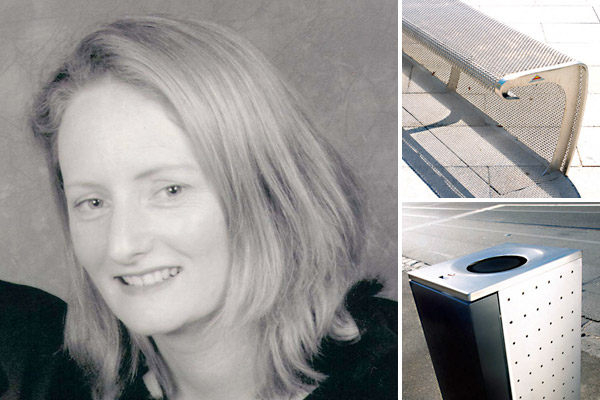
Dryden+Crute Design | Email | Website
Where and what did you study and what year did you graduate?
Bachelor of Interior Design Honours, 1987, RMIT.
Where did you head after graduating?
After graduating I worked at major design firms such as Bates Smart and Geyer on prominent projects.
When did you launch your own business?
In 2003.
What motivated you to start your own business?
It has always been my dream!
How would you describe your business to someone who didn’t know you?
We produce external furniture elements for the public domain, and design for the internal domain. This includes working on corporate, residential, and hospitality projects.
How would you describe the products you design to someone who hadn’t seen them?
Pure elements, which integrate into their individual urban environments as useful furniture.
What are the most challenging parts of being a designer running a small business?
I love a challenge but I do find the dry side of administration is the least fun in the day to day tasks of running a business.
What inspires your design projects?
Collaborating with clients, other designers, manufacturers and builders. Influences come form everywhere and everything to create things of usefulness and beauty. I would also say the poetic qualities of the world around us.
What are the next steps for you?
We want to continue to develop business and marketing skills in order to grow, to develop a web site and continue to produce quality designs for satisfied clients.
Comments Off on Jacquelyn Crute
Jane Barwick and Iris Saar Isaacs
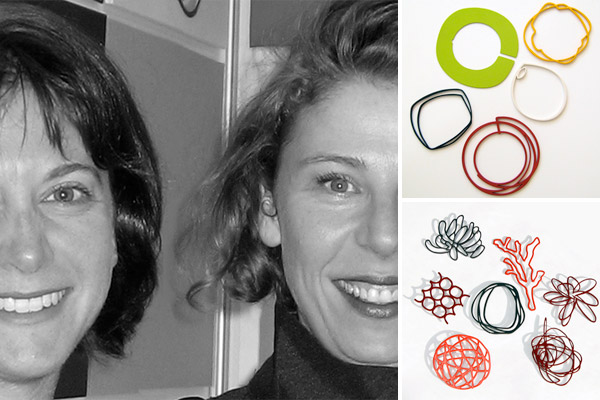
in-sync design | Email | Website
Where and what did you study and what year did you graduate?
Jane: Bachelor of Fine Arts (Gold & Silversmithing), 2002, RMIT.
Iris: Diploma of Design (Silversmithing), 1998, Northern Metropolitan Institute of TAFE, Greensborough.
Three Dimensional Studies, Practical Studio, 1998-99, Victorian College of the Arts.
Where did you head after graduating?
Jane: I made work that I sold on consignment to a number of galleries. I’ve also held positions in publishing, admin…
Iris: I ran my own business Saar Design where I designed and produced jewellery and projects as a freelance designer and visual artist.
When did you launch your own business?
in-sync design was launched in December 2006.
What motivated you to start your own business?
in-sync came from a desire to create a range of products for a wider market. We wanted to use industrial processes and produce products that could be sold outright as opposed to consignment.
How would you describe your business to someone who didn’t know you?
in-sync creates contemporary jewellery with a strong emphasis on colour and a fusion between industrial process and the handmade.
How would you describe the products you design to someone who hadn’t seen them?
in-sync designs are a blend of organic geometry. They are drawings to adorn the body. The products are bold, colourful contemporary jewellery made from stainless steel and powdercoated.
What are the most challenging parts of being a designer running a small business?
Running a creative business is a very demanding and contradictory concept. Trying to stay creative and fresh, whilst maintaining sales, cash flow, and a constant expanding and varied knowledge.
What are the next steps for you?
We want to research and develop representation in overseas markets, maintain and grow our Australian market and continue to create and produce new products.
Comments Off on Jane Barwick and Iris Saar Isaacs
Gretha Oost
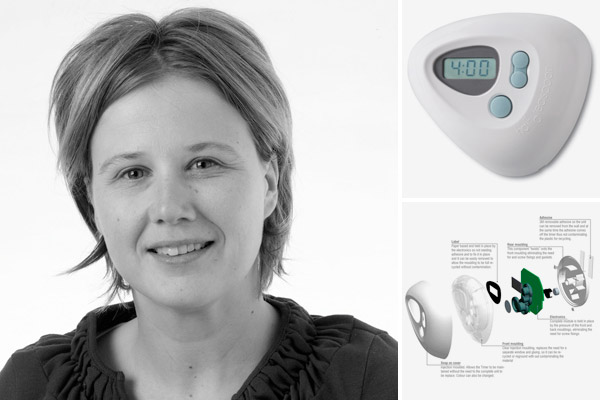
Half A Teaspoon | Email | Website
Where and what did you study and what year did you graduate?
Bachelor of Arts (Communication Management), 1997, University of The Hague, The Netherlands.
Where did you head after graduating?
I worked in a range of marketing and communications positions in the airline and publishing industry. In 2003, I left The Netherlands to ride 11,000 kilometres by bike though South America with my husband Willem. This was a self-initiated sponsored bicycle tour to raise funds and awareness for Oxfam International and their dedicated projects in South America.
What motivated you to start your own business?
Cycling in South America made me a different person. When I arrived in Australia I was in a save the world mindset and hearing all this talk about saving water. I had an idea to create my own environmentally focused company. Then it took some time to come up with a way to engage people without pointing the finger or using the words – ‘save water’.
How would you describe your business to someone who didn’t know you?
Half A Teaspoon aims to create awareness about the world’s limited water resources and stimulate conscious use of water by developing stylish eco-designed products.
How would you describe the products you design to someone who hadn’t seen them?
The ShowerWatch is a pre-programmed four minute water resistant timer for the shower. The soft, water-formed shape is both familiar and intuitive. The form invites touch and feels natural even within the artificial environment of a bathroom.
What are the most challenging parts of being a designer running a small business?
There is just so much to do. There are so many opportunities and being all by yourself, sometimes it is all a bit overwhelming. You are always asking ‘Where do I start?’
What are the next steps for you?
We are now developing a second product with the same focus, to stimulate conscious use of water. The ultimate goal is that the sales of products will generate enough funds to set up a foundation to support water projects locally and around the world.
Comments Off on Gretha Oost
Elliat Rich
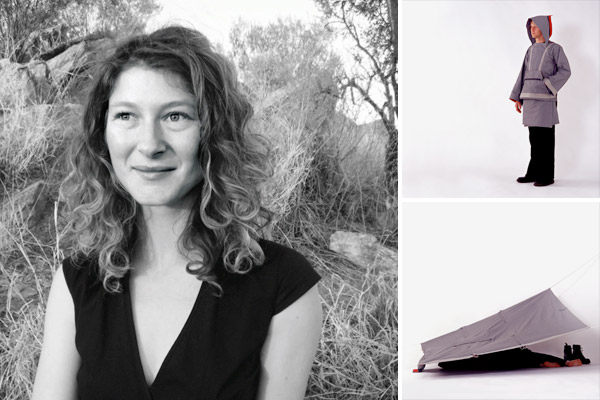
Elliat Rich Design | Email | Website
Where and what did you study and what year did you graduate?
Bachelor of Design Honours (First class), 2006, College of Fine Arts, University of New South Wales.
Where did you head after graduating?
I worked at the Centre for Appropriate Technology in Alice Springs in the Northern Territory for three years.
When did you launch your own business?
In August 2007.
What motivated you to start your own business?
The opportunity to put all my energy into my practice.
How would you describe your business to someone who didn’t know you?
My practice has a conceptual base with an emphasis on inspiring new understandings of sustainability.
How would you describe the products you design to someone who hadn’t seen them?
Commonly the objects I create celebrate the poetry of humble pleasures. They range greatly in the materials they use, the ideas they express and the opportunities they allow. They all have a link to Australia and are Ex Animo, as in from the heart, or spirit, sincerely.
What are the most challenging parts of being a designer running a small business?
The most challenging part is balancing time, not overworking and realising that if I want to keep doing what I love then I have to prioritise making money.
Elliat Rich received scholarships from Arts NT and the Australian Design Unit to participate in Springboard Stage One.
Comments Off on Elliat Rich
Dhiren Bhagwandas
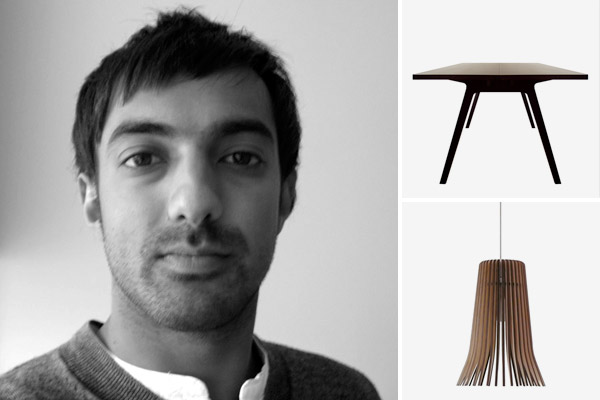
Dhiren Studio | Email | Website
Where and what did you study and what year did you graduate?
Bachelor of Design (Industrial Design), 2002, National Institute of Design, Swinburne University of Technology.
Where did you head after graduating?
I worked as an industrial designer for some years. I then moved to the UK to work as part of a large transport development project in London and returned to launch my own studio in 2006.
When did you launch your own business?
In 2006.
What motivated you to start your own business?
I had identified a need for original designs that are relevant and accessible, as well as the will to have freedom of expression.
How would you describe your business to someone who didn’t know you?
Dhiren Studio is a multidisciplinary design consultancy engaging in progressive works across furniture, lighting and product design.
How would you describe the products you design to someone who hadn’t seen them?
They are contemporary objects that enhance the human experience, while paying close attention to the social and environmental impact of each products existence. I strive to utilise materials and techniques in new and more effective ways in order to deliver beautiful objects that transcend consumer trends.
What are the most challenging parts of being a designer running a small business?
Overseeing every facet of the business and working within a business culture that has only recently opened its eyes to the value of design is also hard work!
What inspires your design projects?
Often everyday, mundane objects such as a street light or a joinery detail. Also the simple beauty of the forms and systems found in nature.
What are the next steps for you?
I will be working on the development and distribution of a new furniture and lighting range, while also growing the creative consulting side of the business.
Dhiren Bhagwandas received a scholarship from Design Victora to participate in Springboard Stage One.
Comments Off on Dhiren Bhagwandas
Deanna Corso
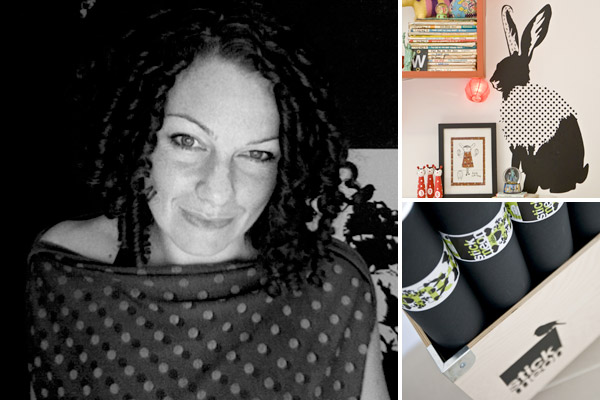
stick meon | Website
Where and what did you study and what year did you graduate?
I studied part time for almost 10 years including Marketing at Swinburne, Multimedia at Melbourne School of Art and Visual Arts at Box Hill TAFE.
Where did you head after graduating?
I sought jobs that not only allowed me to be creative, but also allowed me to learn from others. Working with the marketing and business development teams of an internet service provided during the dot com frenzy was invaluable. However, the most relevant experience would be working within product development for both the homewares and fashion industries.
When did you launch your own business?
I started freelancing graphic design 2002. stick meon was launched in December 2007.
What motivated you to start your own business?
I think its every graphic designer’s dream to have their own product out there. I started to see a lot of products in Melbourne boutiques that made me want to produce something myself. I started to experiment with a medium I was familiar with. Based on friend’s reactions to the prototype I had to keep going!
How would you describe the products you design to someone who hadn’t seen them?
Wall art.
What are the most challenging parts of being a designer running a small business?
To make an idea into a reality takes a lot of decision making and follow through. So when you have a hundred ideas every day, it can be hard to stay focused. And let’s not forget cash flow and bookkeeping!
What inspires your design projects?
Fellow independent designers, design blogs, hours of page flicking at Brunswick Street Bookstore and a love for constantly rearranging my home.
What are the next steps for you?
As the business is in its very early stages, the next couple of years will be all about refining the production process, regularly launching new designs and experimenting with new mediums. Apart from having a product in stores and available online, I also have ideas for collaborating with other designers.
Comments Off on Deanna Corso
Christopher Plumridge
Where and what did you study and what year did you graduate?
Diploma Art and Design (Ceramics), 1978, Bendigo College of Advanced Education.
Where did you head after graduating?
I was a ceramics tutor and technician at Riverina College of Advanced Education in Wagga Wagga and a teacher and technician in ceramics and photography at Preston TAFE in Victoria.
When did you launch your own business?
I started my business in 1994.
How would you describe your business to someone who didn’t know you?
I manufacture and design high quality and functional pottery tableware, cookware and homewares.
How would you describe the products you design to someone who hadn’t seen them?
They are beautifully coloured with clear and matte gloss and crystal finish glaze. All pieces are stylised and refined contemporary forms.
What are the most challenging parts of being a designer running a small business?
As a single operator, it is often a challenge to make everything that is ordered to the client’s schedule and to ensure that cash flow is sufficient to pay the bills as well as purchasing materials and giving yourself an income.
What inspires your design projects?
Natural objects inspire my forms.
What are the next steps for you?
I would like to have some of my smaller top selling products manufactured in a larger volume. This would mean that instead of making them all myself I would either employ people or have single pieces made by another maker or manufacturer to fulfill my demand. This could lead to export sales and possibly large scale production for a global market.
Christopher Plumridge received a Design Victoria scholarship to participate in Springboard Stage One.
Comments Off on Christopher Plumridge
Carmen Blyth
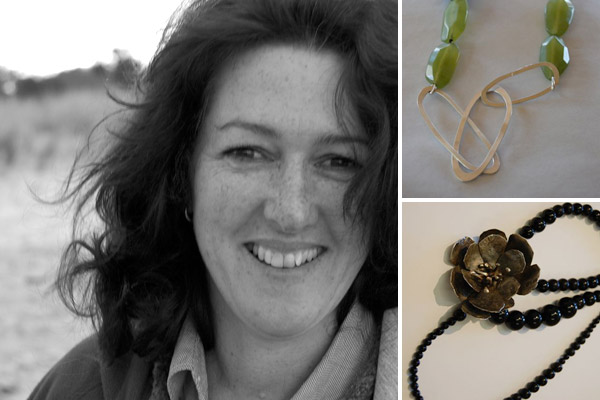
Redhand Design | Email
Where and what did you study and what year did you graduate?
Bachelor of Fine Arts (Printmaking and Furniture Design), 2001, University of Tasmania.
Diploma of Art Craft Design (Jewellery making), TAFE Hobart.
Where did you head after graduating?
When I finished my Bachelor of Fine Arts, I cofounded Rivulet Print Studio which was run as a studio and gallery. During this time, I studied jewellery making at TAFE.
When did you launch your own business?
I set up RED, a jewellery gallery and studio eighteen months ago.
What motivated you to start your own business?
I had a solo jewellery exhibition in 2004 which was well received.
How would you describe your business to someone who didn’t know you?
I would describe my business as more of a studio and a space where I exhibit and am able to meet and tell my story to my clientele.
How would you describe the products you design to someone who hadn’t seen them?
My product is based on one-off or limited edition pieces of wearable sculpture.
What inspires your design projects?
The inspiration for my work comes from the day to day chaos that I call my life and anything and everything.
What are the next steps for you?
My next move is to Europe where my husband is being transferred and I hope to study and do some residencies there. On my return to Australia or Tasmania, I would like to share the knowledge and experience with other artists by setting up an artist retreat and studio gallery on our property.
Carmen Blyth received a scholarship from the Australian Design Unit to participate in Springboard Stage One.
Comments Off on Carmen Blyth
Brigitte de Villiers
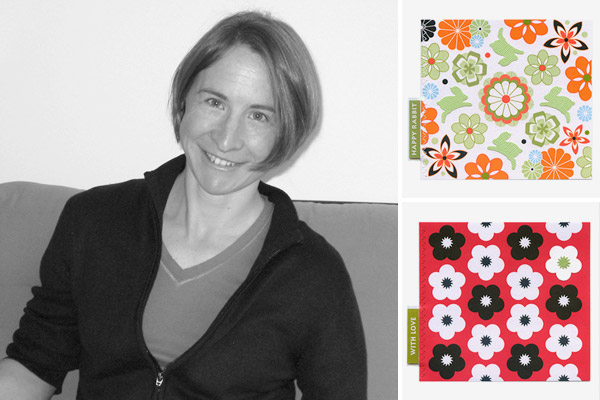
Hit the Spot | Email
Where and what did you study and what year did you graduate?
Bachelor of Science (Environmental and Geographical Science), 1994, University of Cape Town.
Graduate Diploma Information Systems, 2000, University of Tasmania.
Where did you head after graduating?
I moved to England worked with a small team organising major horticultural flower shows including the Chelsea Flower Show. Later I worked as an application developer and a web designer.
When did you launch your own business?
In 2004.
What motivated you to start your own business?
I’ve always had a yearning to build my own business. My parents had several businesses while I was growing up from a printing press, a flower farm and a restaurant so perhaps that’s where the original motivation came from.
How would you describe your business to someone who didn’t know you?
I produce a range of finely crafted greeting cards aimed at people who love quality stationery and appreciate the personal touch.
How would you describe the products you design to someone who hadn’t seen them?
I call the cards ‘tailored gift cards’ as each is individually crafted on my sewing machine. The paper is all acid free and my designs feature vibrant colours and concepts that appeal to young and old.
What are the most challenging parts of being a designer running a small business?
By far the greatest challenge is in finding time to fill orders, come up with new designs and do all the administrative stuff.
What inspires your design projects?
Initially the label concept for the cards was inspired by the red fashion tab on my favourite cardigan. Since then inspiration for new designs comes from anywhere, anything and any time.
What are the next steps for you?
I plan to expand to screenprinted kitchen linen, gift wrap and other stationery lines. Within five years, I intend Hit the Spot to be an internationally established brand of homewares and stationery, and to be in a strong enough financial position to be able to make a positive contribution to the Tasmanian community.
Comments Off on Brigitte de Villiers
